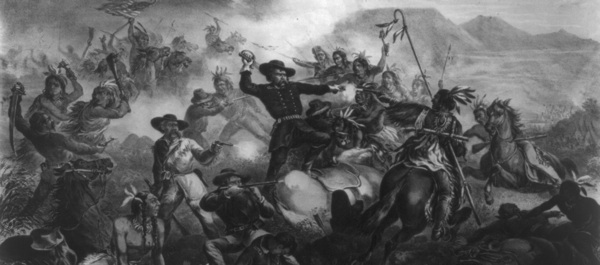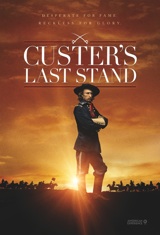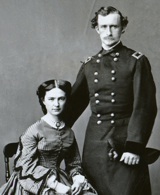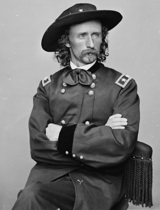
The Boston Tea Party. The Alamo. Lincoln’s Gettysburg Address. Custer’s Last Stand. The Battle of Little Big Horn, fought June 25–26, 1876, and popularly known as Custer’s Last Stand is among the first historical events children learn about in America. It is engrained into popular culture, portrayed hundreds of times in everything from scholarly studies to movies to an Anheuser Busch beer advertisement. Singer-songwriter Tom Paxton wrote about it satirically in “Give Somebody a Medal.”
“Custer’s Land Stand,” a new documentary from the PBS television series American Experience, is the latest to explore the cavalry commander George Armstrong Custer and the battle to which his name is forever linked. “Custer’s Last Stand” premieres on PBS on Tuesday, January 17 at 8:00 p.m. (Check local listings).
 Although it would seem there that by now there is nothing new to present, in fact the documentary does offer fresh aspects of the battle, what led up to it, and the implications of the defeat of the U. S. Army’s 7th Cavalry at the hands of a coalition of Plains tribes under the spiritual and political leadership of Sitting Bull. Some new historical research is presented, but this history lesson transcends the battle to look at the large and enduring myth of Custer, one of America’s most controversial figures.
Although it would seem there that by now there is nothing new to present, in fact the documentary does offer fresh aspects of the battle, what led up to it, and the implications of the defeat of the U. S. Army’s 7th Cavalry at the hands of a coalition of Plains tribes under the spiritual and political leadership of Sitting Bull. Some new historical research is presented, but this history lesson transcends the battle to look at the large and enduring myth of Custer, one of America’s most controversial figures.
“Myths are fascinating things,” says “Custer’s Last Stand” producer-director Stephen Ives. “They’re often based on a kernel of truth but then they take on a life of their own. Exploring a myth and finding out where it came from and how it’s become part of our collective consciousness is a fascinating enterprise. And never more so than in trying to unravel the complicated life of somebody like George Armstrong Custer. He really did embody so many of the contradictions that were part of America’s drive to become a continental nation—that, and the fact that he died in spectacular fashion.”
As director of the acclaimed PBS series The West, Ives saw the potential for expanding the story of one of the west’s most colorful characters.
“Custer has fascinated me ever since I made The West series back in 1996. I never felt like anyone had ever tried to penetrate inside his psyche in a satisfying way. And then Nathaniel Philbrick wrote a new book called The Last Stand, which I felt really did get at that aspect of Custer’s character in an insightful way. And so the time seemed to be right to pull back the curtain on what had often been a stereotyped and simplified view of Custer and try and dig deeper.”
“Custer’s Last Stand” is first and foremost about Custer, his relationships, and what made him tick. And though Philbrick is in the film, this is not a visual representation of the book. The film steps back in Custer’s life and looks at the driving forces behind the carefully planned public persona Custer shaped for himself.
There is no doubt that ambition was an enormous part of Custer’s character. It was evident in his career choice in the military, one of the most visible and powerful professions at the time. It was evident in the way he worked his charisma and image into a rapid rise in rank and power in the Civil War (although he did not alter the outcome of the Battle of Gettysburg with his heroic charge against General “Jeb” Stuart’s Confederate cavalry on July 3, 1863, as the film suggests). Custer’s fame and image also attracted the attention of the woman of his dreams, Elizabeth “Libby” Bacon, whether that was part of his plan or not. (It likely was; her father, an influential judge, thought Custer’s undistinguished family background was a poor match for his daughter).
 “I wanted to explore more about Custer’s relationship with Libby, his wife, who was one of the most extraordinary women of the 19th century, I think,” explains Ives. “Their love affair was truly remarkable. The way in which they had a kind of mutually shared ambition. The way in which they kind of completed each other was really quite moving and quite interesting to me. They were the power couple of their day.”
“I wanted to explore more about Custer’s relationship with Libby, his wife, who was one of the most extraordinary women of the 19th century, I think,” explains Ives. “Their love affair was truly remarkable. The way in which they had a kind of mutually shared ambition. The way in which they kind of completed each other was really quite moving and quite interesting to me. They were the power couple of their day.”
A couple not unlike … the Clintons?
“George and Libby Custer are Bill and Hillary Clinton, on one level,” says Ives. “They’re a tremendously charismatic, powerful, politically astute ambitious couple. They’re glamorous. They’re the kind of people that people want to be around.”
When Custer did run into trouble, Libby picked him up. When he hit a dry spell in his career not long after the Civil War, he reinvented himself as an Indian fighter. Libby was quite willing to take on the challenge, and even excelled as the gracious hostess of the frontier posts to which Custer was assigned. Although there is evidence offered to suggest that Custer may have dallied with other women on his long solo trips to the cities of the east, his real personal problem was gambling. He was, after all, a gambler by nature.
More troubling for him professionally were missteps with other officers and former officers, including then-president Ulysses S. Grant. But Philip Sheridan, who had been in charge of cavalry in the Army of the Potomac during the last months of the Civil War, was always there to lend his protégé a helping hand.
This film is crafted as a journey along the path of Custer’s life to its culmination in his date with destiny on the rolling prairie of southeast Montana. However the military history descriptions of Custer’s victories and defeats are uneven. Some, like the Battle of Washita, are given greater attention than others in the documentary because they develop the picture of Custer’s views of his mission and of what it took to be a leader in this strange kind of warfare the former Union officers had to adjust to. Custer’s approach was not popular with all the Indian fighters who served with and around him. The film suggests that the enemies he made within the ranks would help to doom him.
It is only later in the documentary that the other side, the Native American side, of the events leading up to Battle of Little Big Horn is explored. And this is primarily revealed through the reaction of the Hunkpapa medicine man, Sitting Bull, to the continuous westward expansion of the white man and the cavalry’s part in it.
Ives explains his choices in how he covered the battle and its participants: “I didn’t want to and didn’t make a film for military history buffs. There’s not a blow-by-blow description of exactly how the Last Stand unfolded. I thought it was better to have that take place as a kind of haunting mystery off-stage. I did want to explore the kind of fateful relationships Custer forged between Marcus Reno and Frederick Benteen. I didn’t think I could do justice to the kind of complexity of Custer’s story, or to the mythic afterlife of Custer, if I also brought Crazy Horse and Sitting Bull into the story on an equal footing.”
If the film is the story of Custer—and it really is—this approach makes sense. The overall campaign to force the Lakota and Cheyenne onto the Great Sioux reservation is presented reasonably well. However, the ways the Sioux tribes lived and fought, and how aspects of the culture impacted the warfare, are not developed very well. The formation of the tribal alliance is minimally discussed, only through Sitting Bull’s role in it. Crazy Horse is barely mentioned. The battle is described primarily through what was happening on the south side of the field, where Reno and Benteen were stationed. Granted, they were officers on the scene who survived to provide firsthand accounts.
 Overall, the story aspect of the film is strong when the viewer realizes that it is more about Custer and the myth surrounding the Last Stand than about the battle itself. Examples of the pop-culture development of the myth through movies and literature are presented. These things show the breadth of the fascination with the subject, and the on-camera speakers rev up enthusiasm for the man and the event. Some are stronger and more interesting than others. “Films like this end up having a certain synthesis built into them because we have a kind of Greek chorus of talking heads that help us bring the history back to life,” explains Ives.
Overall, the story aspect of the film is strong when the viewer realizes that it is more about Custer and the myth surrounding the Last Stand than about the battle itself. Examples of the pop-culture development of the myth through movies and literature are presented. These things show the breadth of the fascination with the subject, and the on-camera speakers rev up enthusiasm for the man and the event. Some are stronger and more interesting than others. “Films like this end up having a certain synthesis built into them because we have a kind of Greek chorus of talking heads that help us bring the history back to life,” explains Ives.
But a film should be visually interesting as well. “Custer’s Last Stand” utilizes familiar American Experience techniques of still-life motifs, photographs and some beautiful vistas of Little Bighorn Battlefield National Monument. Because this is a very long film the photographs, probably the best available, are stretched too thin. More interesting is the way Ives uses battle recreation scenes, pushing the envelope of this form in a way not seen since We Shall Remain. It would be wise for other American Experience programs to do the same to keep the visual element of these programs as interesting as the content.
It is probably no surprise to anyone to learn, whether through viewing this documentary or experiencing other historical accounts, that Custer was intent on building a legacy and a legend for himself. “Live hard, die hard,” the saying goes. It is those who take risks, often controversial ones, who will be remembered. Custer probably knew that, as have others who followed and will continue to follow him on the path of celebrity and notoriety.
“I think that’s why I love him,” Ives says. “Because he’s in some ways, a creature of his age, but at the same time he’s a very modern, very familiar character.”
For readers who would like to know more about the Sioux’s point of view, click here to read an eyewitness account by Lakota Sioux Chief Red Horse.
About the Author:
Jay Wertz is the producer-director-writer of the award-winning 13-part documentary series Smithsonian’s Great Battles of the Civil War for The Learning Channel and Time-Life Video. He is also the author of The Native American Experience and The Civil War Experience 1861-1865 and co-authored Smithsonian’s Great Battles and Battlefields of the Civil War with prominent historian Edwin C. Bearss. His most recent publication is due out in January 2012, D-Day: The Campaign Across France, the second volume in the War Stories series, published by World History Group Publications.




